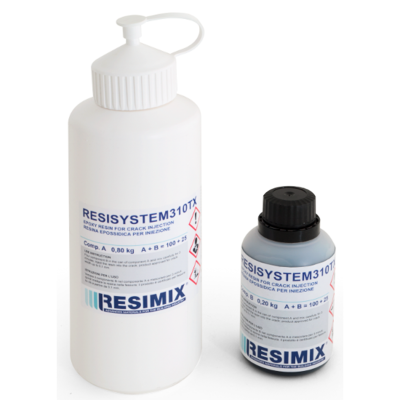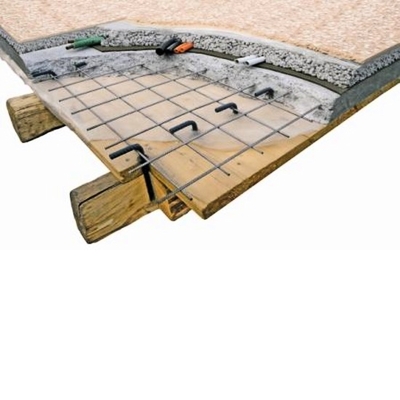RESISYSTEM 310 TX
EPOXY FLUID FORMULATION FOR STRUCTURAL INJECTIONS
Low viscosity, solvent-free epoxy system. Recommended for structural injection into cracks and gaps in masonry and concrete, bricks, stone, tufa, marble etc. and for bedding and anchoring vertical shear connectors.
Slight thixotropy (unlike RESISYSTEM 310) the version TX is fit for injection in crack from 1 to 2 mm.
RESISYSTEM 310 provides an effective bonding because it has excellent adhesion to all building materials (concrete, steel, brick, etc.) in both wet and dry conditions. Its low viscosity also allows to block even the narrowest slots inside a masonry ensuring a high adhesion surface; the reaction between the two components, resin and hardener, takes place by polyaddition or without the formation of secondary products resulting in a hardening without shrinkage.
A consolidation with RESISYSTEM 310 provides:
- high mechanical properties (tensile and compression) and low modulus of elasticity;
- complete irreversibility of the hardening reaction and therefore stability and aging resistance of the hardened product;
- high chemical resistance against acid and basic solutions and gaseous pollutants;
- implementing practical and secure with pumping system operates up to a recommended pressure from 1 to 4 atm;
| Technical characteristics | U.M | |||||||||||||
|---|---|---|---|---|---|---|---|---|---|---|---|---|---|---|
| Compression strenght | > 70 | N/mm2 | ||||||||||||
| Tensile strenght (EN ISO 3251) | 63 | N/mm2 | ||||||||||||
| Ultimate elongation (EN ISO 3251) | 1,3 | % | ||||||||||||
| Resistance to bending and traction (ISO 178) (ISO 178) | > 45 | N/mm2 | ||||||||||||
| Traction elasticità modulus (EN ISO 3251) | 3940 | N/mm2 | ||||||||||||
| Adhesion to dry concrete (*) (ISO 4624) (ISO 4624) | > 4,5 | N/mm2 | ||||||||||||
| Adhesion to wet concrete (*) (ISO 4624) (ISO 4624) | > 2, 5 | N/mm2 | ||||||||||||
| Adhesion to steel (*) | 3 | N/mm2 | ||||||||||||
| Density | 1,10 | kg/dm3 | ||||||||||||
| Mix ratio A + B | 100 + 25 |
Values achieved after 7 day hardening at 25°C.
(*) Adhesion test carried out through direct traction
Viscosity as a function of temperature
| TEMPERATURE | RESISYSTEM 310 TX | |||||||||||||
|---|---|---|---|---|---|---|---|---|---|---|---|---|---|---|
| 10 °C | 500 - 900 cP | |||||||||||||
| 20 °C | 400 - 600 cP | |||||||||||||
| 30 °C | 200 - 400 cP |
Preparation of the support
Welding of cracks: open the cracks or the injection point by removing the loose parts and carefully aspirate dust or blow it out with compressed air.
In the widest points, drill Ø 10 mm holes 5 cm deep at a distance of 20-30 cm from each other to facilitate the entry of the resin; in correspondence to the holes fix the nipples (injection valves fitted with non-return device) with the appropriate adhesive RESICOL 100.
With the same product, seal the slot and wait until complete set, from 6 to 12 hours depending on the temperature.
Insert into the nipples a vent tube that allows air to escape during the injection of the product.
Preparation of the product
Pour component B into component A according to the weight ratio indicated in the packaging.
Mix for 3 '- 5' at low speed with a drill fitted with a helical/spiral incorporating less air as possible; during this operation, mix the product even on the bottom and on the walls of the bucket.
Application
Repairing cracks
Inject the product through the nipples with a variable pressure special gun, not exceeding 4 atm ( the non-return valve works between 1 and 4 atm) ; the injection should be done starting from the lower nipple so that the air can escape from higher one.
Use pumps for two component systems, with variable and controlled pressure, fitted with static or dynamic mixer; alternatively, use diaphragm pumps, lobe pumps or autoclaves.
When the resin appears in the upper nipple, remove the pump hose and connect it the same way to the next nipple: continue until complete blockage of the cracking.
After a few minutes, repeat the operation to restore the material that was absorbed from the media.
At the end of hardening , which is completed in 12-15 hours, remove the nipple and the grout on the surface with a chisel and smooth with a abrasive disc.
Grouting of connectors
Pierce with a drill or a rotary hammer drill, carefully aspirate dust or blow compressed air.
Fill the hole with RESISYSTEM 310 for about half of its volume; insert the connector by rotating it in the hole so that air bubbles are expelled, then insert it completely and do not move during the curing phase.
The hole diameter should be 4 mm more than the diameter of the connector so as to leave a circular ring of 2 mm thickness.
Notes
Carefully examine the cracking before starting work: RESISYSTEM 310 is especially suitable for loops in compact construction materials (eg concrete), when you can know the depth and length to calculate the volume and therefore the amount of material necessary for its complete blocking.
Avoid use in blind lesions and non-homogeneous materials (eg stone walls) because the product is dispersed.
Three basic rules apply to all two-component systems: weigh well, mix thoroughly the bottom and sides, respect the time of use. In the case of partial use of packages, the components must be weighed according to the report A + B indicated on the label and not measured by volume.
When mixing the reaction between the two components starts: time available is therefore limited and it depends on the temperature.
| TEMPERATURE | RESISYSTEM 310 TX | |||||||||||||
| 10° C | 500 - 900 cP | |||||||||||||
| 15° C | 400 - 600 cP | |||||||||||||
| 20° C | 200 - 400 cP |
Full hardening after 7 days.
To determine the need for RESISYSTEM 310 you should estimate the volume of the crack to fill: 1 kg of product fills about 1 dm3.
Available in packages (component A + B) of 1 kg, 5 kg, 10 kg and 25 kg.
The packages should be kept in an upright position and closed: the product remains unchanged for at least a year if it is kept closed and protected with a temperature between 10 and 30 °C.
RESISYSTEM 310 is used to perform injections for structural consolidation in passing or blind cracks not exceeding 1 mm of width on walls of solid materials such as concrete, brick, stone, tuff, wood and in general for:
- Concrete structural welding of beams, pillars and civilian engineering works;
- Strengthening of damaged concrete, solid brick, rock or stone masonry (in this case by previously filling in voids with fluid cement mortar);
- Fixing of steel and plastic reinforced by fibreglass fixed to wood and concrete connectors and with comb stitch of structural damages;
- Gluing of steel-concrete-wood elements, composite slab connectors with wooden beams, window sills, steps, unglued cement screeds.



